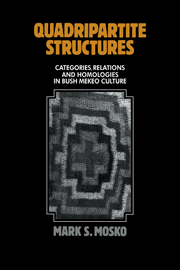Book contents
- Frontmatter
- Contents
- List of figures, tables, and maps
- Preface
- 1 Introduction: the problem and the people
- 2 Between village and bush
- 3 Body and cosmos
- 4 Sex, procreation, and menstruation
- 5 Male and female
- 6 Kin, clan, and connubium
- 7 Feasts of death (i): de-conception and re-conception
- 8 Feasts of death (ii): the sons of Akaisa
- 9 Tikopia and the Trobriands
- 10 Conclusions: indigenous categories, cultural wholes, and historical process
- Appendixes
- Notes
- Bibliography
- Index
1 - Introduction: the problem and the people
Published online by Cambridge University Press: 04 August 2010
- Frontmatter
- Contents
- List of figures, tables, and maps
- Preface
- 1 Introduction: the problem and the people
- 2 Between village and bush
- 3 Body and cosmos
- 4 Sex, procreation, and menstruation
- 5 Male and female
- 6 Kin, clan, and connubium
- 7 Feasts of death (i): de-conception and re-conception
- 8 Feasts of death (ii): the sons of Akaisa
- 9 Tikopia and the Trobriands
- 10 Conclusions: indigenous categories, cultural wholes, and historical process
- Appendixes
- Notes
- Bibliography
- Index
Summary
This account of a Papuan culture is avowedly structuralist. In this view, ethnographic description and explanation essentially consist of translating the meanings of indigenous culture categories into our own language, and constructing in the process a model of the total culture (Schneider 1972, 1980). For non-Western cultures like the Bush Mekeo, meanings cannot be assigned or adduced either a priori or ad hoc from Western concepts. Rather, meaning, as argued by Saussure in terms of linguistic value (1959), is neither random nor piecemeal, but systematic and logical. It resides in the interrelations among indigenous categories, in their relations of difference and similarity, in the underlying structure of ideas. Moreover, the meanings of particular cultural elements are inseparable from the wider synchronic “whole” or “totality.”
The notions of meaning, indigenous category, structure, and cultural whole are thus central to my treatment of Bush Mekeo traditions.
In the current “post-structuralist” era (Kurtzweil 1980; see also Friedman 1974) there has been a tendency for these conceptions to be superseded by reemphases upon social action, history, and diachrony. Undoubtedly, the revival of Marxian approaches (e.g., among others, Friedman 1974; Worseley 1968; Harris 1968; Sahlins 1972; Bourdieu 1977; Godelier 1977) is largely responsible. Although certain elements of this development are necessary and welcome, others are premature if not regrettable – premature in that some of the most valuable and useful insights deriving from the structuralist perspective have been passed over without yet receiving adequate opportunity for empirical verification, and regrettable in that the risks have consequently increased of seriously distorting our conception and understanding of the essential nature of cultural systems and how they are constituted.
- Type
- Chapter
- Information
- Quadripartite StructuresCategories, Relations and Homologies in Bush Mekeo Culture, pp. 1 - 20Publisher: Cambridge University PressPrint publication year: 1985



